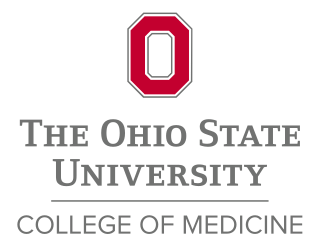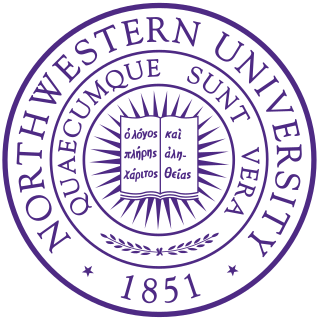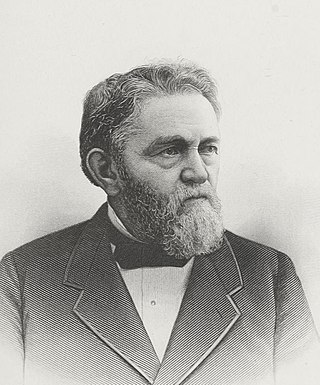
The Ohio State University is a public land-grant research university in Columbus, Ohio, United States. A member of the University System of Ohio, it was founded in 1870. It is one of the largest universities by enrollment in the United States, with nearly 50,000 undergraduate students and nearly 15,000 graduate students. The university consists of sixteen colleges and offers over 400 degree programs at the undergraduate and graduate levels.

The Temerty Faculty of Medicine is the medical school of the University of Toronto. Founded in 1843, the faculty is based in Downtown Toronto and is one of Canada's oldest institutions of medical studies, being known for the discovery of insulin, stem cells and the site of the first single and double lung transplants in the world.

Oklahoma State University Center for Health Sciences (OSU-CHS) is a public medical school in Tulsa, Oklahoma. It also has a branch campus in Tahlequah, Oklahoma. Founded in 1972, OSU-CHS is part of the Oklahoma State University System. OSU-CHS offers a Doctor of Osteopathic Medicine (D.O.) and over fifteen other different graduate degrees.

Northeast Ohio Medical University (NEOMED) is a public medical school in Rootstown, Ohio, United States. It specializes in graduate education in medicine and pharmacy but also has a College of Graduate Studies.

Norton Strange Townshend was an American physician and politician who served on term as a United States representative from Ohio from 1851 to 1853.
The University of Maryland School of Medicine, located in Baltimore City, Maryland, U.S., is the medical school of the University of Maryland, Baltimore and is affiliated with the University of Maryland Medical Center and Medical System. Established in 1807 as the College of Medicine of Maryland, it is the first public and the fifth oldest medical school in the United States. UMB SOM's campus includes Davidge Hall, which was built in 1812, and is the oldest building in continuous use for medical education in the Northern Hemisphere.

The Ohio State University College of Medicine is the medical school at Ohio State University. It is located in Columbus, Ohio. The college is nationally recognized as a top institution in both education and research, as reflected by rankings in U.S. News & World Report, Tier 1 in Best Medical Schools: Research. In 2023, its two primary teaching hospitals were ranked as one of the best hospitals in the US in 9 and 10 different specialties, respectively; and Nationwide Children's Hospital was named to U.S. News & World Report's select honor roll of US Best Children's hospitals.

The Feinberg School of Medicine is the medical school of Northwestern University and is located in the Streeterville neighborhood of Chicago, Illinois. Founded in 1859, Feinberg offers a full-time Doctor of Medicine degree program, multiple dual degree programs, graduate medical education, and continuing medical education.

Daniel Drake was a pioneering American physician and prolific writer.

John Woodworth Wilce was an American college football player and coach, physician, and university professor. He served as the head football coach at Ohio State University from 1913 to 1928, compiling a record of 78–33–9. Wilce coached Chic Harley and led Ohio State to their first win over rival Michigan in 1919. He was inducted into the College Football Hall of Fame as a coach in 1954.

Nationwide Children's Hospital is a nationally ranked pediatric acute care teaching hospital located in the Southern Orchards neighborhood of Columbus, Ohio. The hospital has 673 pediatric beds and is affiliated with the Ohio State University College of Medicine. The hospital provides comprehensive pediatric specialties and subspecialties to infants, children, teens, and young adults aged 0–21 throughout Ohio and surrounding regions. Nationwide Children's Hospital also sometimes treats adults that require pediatric care. Nationwide Children's Hospital also features an ACS-verified Level 1 Pediatric Trauma Center, one of four in the state. The hospital has affiliations with the nearby Ohio State University Wexner Medical Center. Nationwide Children's Hospital is located on its own campus and has more than 1,379 medical staff members and over 11,909 total employees.

The Ohio State University College of Dentistry is one of the graduate and professional schools of Ohio State University. The college is the fourth largest public dental school in the U.S. and consists of nine academic divisions representing all major dental specialties. In addition to the Doctor of Dental Surgery (D.D.S.) and Bachelor of Science in Dental Hygiene degrees, the Ohio State College of Dentistry offers specialty training programs, advanced training programs, MS programs, and a Ph.D. program in Oral Biology. Outreach and Engagement activities include over 60 active programs and more than 42 extramural sites, which continue to expand.
Ohio State University was founded in 1870 as a land-grant university in accordance with the Morrill Act of 1862 under the name of Ohio Agricultural and Mechanical College. The school was originally situated within a farming community located on the northern edge of Columbus, and was intended to matriculate students of various agricultural and mechanical disciplines. The university opened its doors to 24 students on September 17, 1873. In 1878, the first class of six men graduated. The first woman graduated the following year. In 1900, in light of its expanded focus, the college permanently changed its name to the now-familiar "The Ohio State University". Ohio State began accepting graduate students in the 1880s, with the university awarding its first master's and doctoral degrees in 1886 and 1890 respectively. 1891 saw the founding of Ohio State's law school.

The Health Sciences Center for Global Health (HSCGH) at The Ohio State University (OSU) is a collaborative program among the OSU Colleges of Dentistry, Medicine, Nursing, Optometry, Pharmacy, Public Health, School of Health and Rehabilitation Sciences and Veterinary Medicine. The HSCGH is led jointly by the Colleges of Medicine (COM) and Public Health (CPH).

The Ohio State University Wexner Medical Center (OSUWMC) is a multidisciplinary academic medical center located in Columbus, Ohio, United States, on the main campus of Ohio State University. For 29 consecutive years, U.S. News & World Report has recognized Ohio State Wexner Medical Center specialties in its "Best Hospitals" rankings. In 2021, it recognized 10 Ohio State Wexner Medical Center specialties: Ear, Nose and Throat #8; Diabetes and Endocrinology #19; Cancer #27; Neurology and Neurosurgery #28; Pulmonology and Lung Surgery #29; Urology #31; Rehabilitation #31; Cardiology and Heart Surgery #38; Gynecology #46; and Gastroenterology and GI Surgery #50. USNWR also named the Ohio State Wexner Medical Center the best hospital in central Ohio and the second best hospital in the state.

Dr. Harold L. Paz is the former executive vice president of health sciences at Stony Brook University and former chief executive officer of Stony Brook University Medicine. He is the former executive vice president and chancellor for health affairs at Ohio State University and chief executive officer of the Ohio State Wexner Medical Center. Prior to that, he served as executive vice president and chief medical officer at CVS Health/Aetna.
Rebecca D. Jackson was a medical researcher, medical practitioner and professor of endocrinology, diabetes and metabolism. Her research was significant in the understanding and treatment of osteoporosis. She also researches the opioid crisis in Ohio.
Jacqueline Nwando Olayiwola is an American family physician, public health professional, author, professor, and women's empowerment leader. She is the Senior Vice President and Chief Health Equity Officer of Humana and a chair and Professor in the Department of Family Medicine at Ohio State University Wexner Medical Center. Prior to her appointment at OSU, she served as the inaugural Chief Clinical Transformation Officer for RubiconMD, an eConsult platform that improves primary care access to specialty care for underserved patients. Olayiwola is dedicated to serving marginalized patient populations and addressing the social determinants through community and technology-based infrastructures of healthcare reform. She has published articles on the use of eConsults and telehealth to provide underserved patients with primary care treatments so that they have a low cost and efficient means of reaching specialized care. Olayiwola has founded numerous non-profits and healthcare start-ups such as GIRLTALK Inc, Inspire Health Solutions LLC, and the Minority Women Professionals are MVPs Program. She has been recognized at the national and international level for her work and efforts to educate, advocate and provide healthcare to those in need. She was named Woman of the Year by the American Telemedicine Association in 2019, and received the Public Health Innovator Award from Harvard School of Public Health in 2019, as well as being named one of America's Top Family Doctors from 2007 to 2008 by the Consumers Research Council of America.

William Heath Byford was an American physician, surgeon, gynecologist and advocate of medical education for women who was most notable for founding the Chicago Medical College and Woman's Medical College of Chicago.

Clotilde Dent Bowen was a psychiatrist who became the first African-American woman to reach the rank of colonel in the U.S. Army. Bowen was also the first African-American woman to graduate in medicine from Ohio State University, the first Black physician to hold a military commission, and the first woman commander of a U.S. military hospital. In 1970, Bowen served in the Vietnam War, as chief psychiatrist for the U.S. Army. She was awarded a Bronze Star and American Legion of Merit in 1971 for her work in establishing drug treatment centers and her efforts to reduce racial tensions in Vietnam. She was also awarded a Meritorious Service Medal. Bowen continued to advocate for services and support for services for drug dependency, support for soldiers with post-traumatic stress disorders, and human rights.















